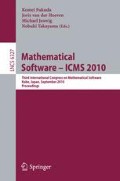Abstract
Euler’s polyhedron formula asserts for a polyhedron p that V − E + F = 2, where V, E, and F are, respectively, the numbers of vertices, edges, and faces of p. Motivated by I. Lakatos’s philosophy of mathematics as presented in his Proofs and Refutations, in which the history of Euler’s formula is used as a case study to illustrate Lakatos’s views, we formalized a proof of Euler’s formula formula in the mizar system. We describe some of the notable features of the proof and sketch an improved formalization in progress that takes a deeper mathematical perspective, using the basic results of algebraic topology, than the initial formalization did.
Access this chapter
Tax calculation will be finalised at checkout
Purchases are for personal use only
Preview
Unable to display preview. Download preview PDF.
References
Alama, J.: Euler’s polyhedron formula. Formalized Mathematics 16(1), 7–17 (2008), http://mizar.org/fm/2008-16/fm16-1.html
Euler, L.: Demonstratio nonnullarum insignium proprietatum quibus solida hedris planis inclusa sunt praedita. Novi Commentarii Academiae Scientarum Petropolitanae 4, 94–108 (1758)
Euler, L.: Elementa doctrinae solidorum. Novi Commentarii Academiae Scientarum Petropolitanae 4, 109–140 (1758)
Juskevich, A.P., Winter, E. (eds.): Leonhard Euler und Christian Goldbach: Briefwechsel 1729-1764. Akademie-Verlag, Berlin (1965)
Lakatos, I.: Proofs and Refutations: The Logic of Mathematical Discovery. Cambridge University Press, Cambridge (1976)
mizar, http://www.mizar.org
Poincaré, H.: Sur la généralisation d’un théorème d’Euler relatif aux polyèdres. Comptes Rendus de Séances de l’Academie des Sciences 117, 144 (1893)
Poincaré, H.: Complément à l’analysis situs. Rendiconti del Circolo Matematico di Palermo 13, 285–343 (1899)
Pontryagin, L.S.: Foundations of Combinatorial Topology. Dover Publications, New York (1999)
Samelson, H.: In defense of Euler. L’Enseignement Mathématique 42, 377–382 (1996)
Spanier, E.H.: Algebraic Topology. Springer, Heidelberg (1968)
Author information
Authors and Affiliations
Editor information
Editors and Affiliations
Rights and permissions
Copyright information
© 2010 Springer-Verlag Berlin Heidelberg
About this paper
Cite this paper
Alama, J. (2010). Euler’s Polyhedron Formula in mizar . In: Fukuda, K., Hoeven, J.v.d., Joswig, M., Takayama, N. (eds) Mathematical Software – ICMS 2010. ICMS 2010. Lecture Notes in Computer Science, vol 6327. Springer, Berlin, Heidelberg. https://doi.org/10.1007/978-3-642-15582-6_26
Download citation
DOI: https://doi.org/10.1007/978-3-642-15582-6_26
Publisher Name: Springer, Berlin, Heidelberg
Print ISBN: 978-3-642-15581-9
Online ISBN: 978-3-642-15582-6
eBook Packages: Computer ScienceComputer Science (R0)

